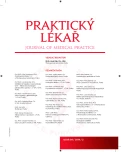-
Medical journals
- Career
Assessment of fitness to work at night
Authors: M. Rakárová
Authors‘ workplace: Ochrana zdraví ; Vedoucí pracoviště: doc. MUDr. Miroslav Bartoš, CSc. ; ŠKODA AUTO a. s., Mladá Boleslav
Published in: Prakt. Lék. 2014; 94(2): 75-78
Category: Of different specialties
Overview
Working at night has become a widespread phenomenon. Based on the figures of various statistics, there are 18–30 % of economic active population, more men than women, who work at night. Working at night is necessary for some professions (members of the emergency system), for other professions it is the result of an economic interest – our society requires some services to be provided 24 hours a day, owners of industrial enterprises introduce various shift systems in order to obtain the fastest possible return on their investments. According to the Czech legal requirements (Act No. 262/2006 Coll., Labour Code, §94) is every employer obliged to provide for their employees, before they are placed for work at night, an occupational medical examination. The examination is then performed regularly at least once a year or at any time when an employee asks for it. The costs of these examinations are covered by employers. The article summarizes the present knowledge of effects of work at night on the human body and contraindications to such work.
Keywords:
circadian system – night work – assessment of fitness to work – contraindications
Sources
1. Costa G. Shift work and occupational medicine: an overview. Occup Med 2003; 53(2): 83–88.
2. Costa G. Shift work and health: current problems and preventive actions. Saf Health Work, 2010; 1(2): 112–123.
3. Illnerová H, Sumová A. Vnitřní časový systém. Interní Med. 2008; 10(7–8): 350–352.
4. Knutsson A. Health disorders of shift workers. Occup Med 2003; 53 : 103–108.
5. Kolstad HA. Nightshift work and risk of breast cancer and other cancers – a critical review of the epidemiologic evidence. Scand J Work Environ Health 2008; 34(1): 5–22.
6. Van Mark A, Spallek M, Kessel R, Brinkmann E. Shift work and pathological conditions. J Occup Med Toxicol 2006; 1 : 25. Dostupné na: http://www.occup-med.com/content/1/1/25.
7. Poole EM, Schernhammer ES, Tworoger S. Rotating night shift work and risk of ovarian cancer. Cancer Epidemiol Biomarkers Prev 2011; 20(5): 934–938.
8. Richter K, Acker J, Kamcev N, et al. Recomendations for prevention of breast cancer in shift workers. EPMA J 2011; 2(4): 351–356.
9. Schernhammer ES, Razavi P, Li TY, et al. Rotating night shifts and risk of skin cancer in the nurse´s health study. J Natl Cancer Inst 2011; 103 : 602–606.
10. Tuček M, Cikrt M, Pelclová D. Pracovní lékařství pro praxi. Praha: Grada Publishing 2005.
11. Ministerstvo zdravotnictví ČR. Vyhláška 79/2013 o provedení některých ustanovení zákona 373/2011 Sb., o specifických zdravotních službách (vyhláška o pracovnělékařských službách a některých druzích posudkové péče).
12. Píšová J. Cirkanuální biorytmy u člověka – KVS. Bakalářská práce. Brno: MU Přírodovědecká fakulta, 2008. Dostupné na: https://is.muni.cz/th/184509/prif_b/prace.pdf.
Labels
General practitioner for children and adolescents General practitioner for adults
Article was published inGeneral Practitioner

2014 Issue 2-
All articles in this issue
- Poverty
- Allergic bronchopulmonary aspergillosis
- Up-to-date radiotherapy for prostate cancer
- Discussions on ethical issues of medicine and health care as an integral part of teaching ethics to medicine students
- Assessment of fitness to work at night
- Laxatives – safe and effective
- One year experience with dependence degree assessment for the purpose of care allowance
- Molecular mechanisms of anti-cancer treatment resistance in prostate tumours
- Premature ejaculation
- General Practitioner
- Journal archive
- Current issue
- Online only
- About the journal
Most read in this issue- Assessment of fitness to work at night
- Laxatives – safe and effective
- Allergic bronchopulmonary aspergillosis
- Up-to-date radiotherapy for prostate cancer
Login#ADS_BOTTOM_SCRIPTS#Forgotten passwordEnter the email address that you registered with. We will send you instructions on how to set a new password.
- Career

